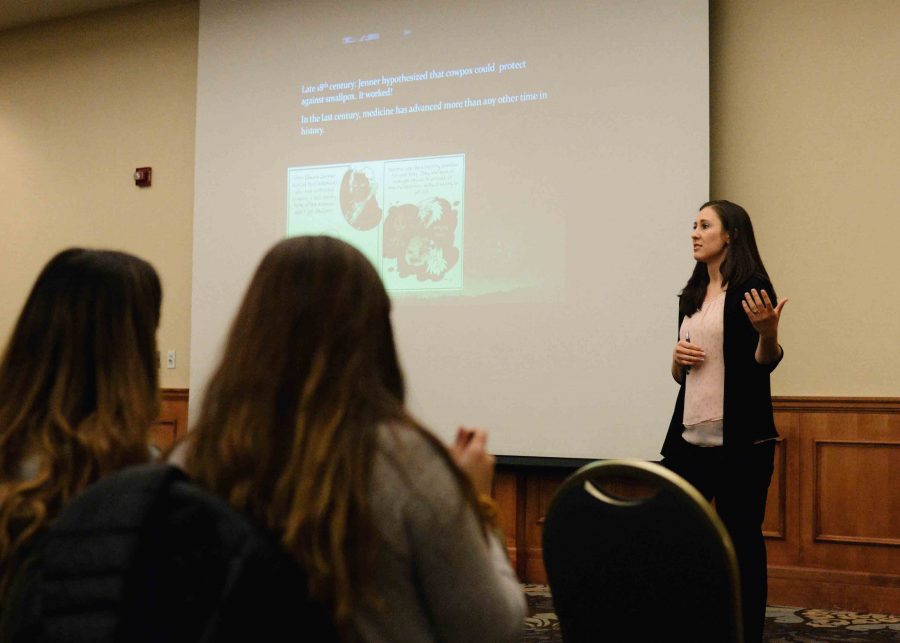Vaccines 101: How they really work
Dr. Andrea Moyer talks to students about the benefits of vaccinations.
Vaccines have been under debate since Andrew Wakefield published a now-discredited study in 1998 claiming a correlation between autism and vaccinations.
In an effort to clear things up, the Oakland University Pre-Medical Society hosted a discussion on the evolution and efficacy of vaccines from 12-1 p.m. on Thursday, March 2 in Banquet Room A of the Oakland Center.
Dr. Andrea Moyer and Biological Sciences Professor Janell Hallauer ran the event and chose to address the topic of vaccinations due to a suggestion that medical professionals should operate under the assumption that the general public has a fifth-grade education when it comes to medical issues.
They defined the term vaccination as “when we stimulate an immune response without actually infecting a person with a dangerous organism.”
Moyer began the presentation with the history of how vaccines first came about.
Moyer reported that in the 17th and 18th centuries, a common technique for treating diseases was bloodletting, which is assumed to be what killed President George Washington.
When smallpox, which is transmitted through inhalation, began killing three to 25 out of every 1,000 people, an English physician and scientist named Edward Jenner discovered that those who had been sick with cowpox, a far milder condition, were immune to smallpox.
This discovery is regarded as the world’s first vaccine.
According to Moyer, medicine has advanced more in the last century than during any other time in history.
There are two types of vaccines: attenuated and inactivated.
Attenuated vaccines are best described as “weakened.” They contain viruses modified to cause no harm, but expose the body to the virus, so the immune system is prepared to fight it later on, if need be.
Inactivated vaccines are grown in a lab, then killed with heat or chemicals. This type of vaccination requires booster shots to build immunity.
“Each time you’re exposed to an organism, your body responds faster and more forcefully and more efficiently, and you make more and more antibodies,” Moyer said.
Moyer said the effectiveness of vaccines is more related to a person’s immune response than to the vaccine itself, and having side effects doesn’t mean the vaccine isn’t working.
Hallauer also spoke briefly on the reasons that people choose not to get vaccinated, discussing Wakefield’s now-disgraced report in great detail.
“The problem is, it’s really easy to scare everybody,” Hallauer said. “But what takes a long time and is much more difficult is to reverse is that fear.”
She compared refusing to vaccinate to a parent refusing to take a child to the hospital for a broken leg. She questioned whether not vaccinating could be consider abuse or neglect, as well.
Hallauer said there is no need to be afraid of vaccines’ contents.
She used the example of arsenic, which she said is also in our drinking water and, therefore, not dangerous in small doses.
“People are scared of the stuff that’s in vaccines,” she said. “I still think you should be more afraid of the stuff that’s in McDonald’s.”
The Pre-Medical Society is a student organization that aims to help interested undergraduate students understand the medical field.
Its next event will be Pre-Health Networking at 5 p.m. Monday, March 6 in Banquet Room A of the OC.
The society will also be hosting Anne Snyder from the Michigan State University College of Osteopathic Medicine’s admissions office at 12 p.m. on Thursday, March 16 in Rooms 128-130 of the OC. Snyder will speak on the college’s admissions process, as well as how osteopathic medical schools differ from allopathic medical schools.









Mark Wax • Mar 8, 2017 at 7:21 AM
“Vaccines Are Unavoidably Unsafe”
Don’t take my word for it. These are the words of Justice Scalia in Bruesewitz v. Wyeth, LLC in a Supreme Court decision in 2011. Unfortunately, due to the protections afforded the vaccine maker in the National Childhood Vaccine Act of 1986, the Court ruled against a vaccine injured plaintiff in the case. How?
In the 1980s, children were having adverse reactions to the DTP (diphtheria, tetanus and pertussis) vaccine. Lots of lawsuits were being filed against docs and vaccine manufacturers. This caused the pharmaceutical industry to threaten pulling out of the vaccine market, and the alarm bells rang that the nation’s health and safety were at risk. Why were vaccine manufacturers getting ready to take their ball and go home? Because vaccines fall into a class of products considered “unavoidably unsafe.” I am not kidding you. This “unavoidable” word comes from the National Childhood Vaccine Injury Act itself “products which, in the present state of human knowledge, are quite incapable of being made safe.”
In 1986, Congress decided on a way to compensate folks for these avoidable injuries and death. It is called the National Vaccine Injury Compensation Program. From 2001 until 2011 the program has compensated about 2500 families a total of $2 billion. There has been close to $4 billion paid to date since inception. But, that represents only a small fraction of those who actually brought claims to the Vaccine Court. You see, there is a 36 month window to bring the claim. There is no “tolling” granted for minors, unlike all the Civil Courts in the U.S. Guess what? Neurological injuries may not present in infants for long after 36 months. Furthermore, who knows how many cases were never brought by attorneys on behalf of a vaccine injured child, because the statute of limitations ran out?
Don’t let anyone tell you that vaccines don’t cause injury. They have, they do and they will do so in the future. For years, Thimerosal was used as a preservative in multi-dose vials. While still proclaiming it “safe”, vaccine makers “voluntarily” removed Thimerosal. It is still present in trace amounts and in flu vaccine. Thimerosal was never approved by the FDA, as the patents predated the establishment of said regulations. Worried?
With nearly 6,000 cases pending the USCFC held the “Omnibus Autism Hearings.” They decided not to make “autism” a “table injury.” How convenient. Since there would never be enough money to pay for all who claim an “autism” injury. But, there have been many cases compensated for “encephalopathy” as a diagnosis with reference to autism. You can read it: http://digitalcommons.pace.edu/cgi/viewcontent.cgi?article=1681&context=pelr
For the record, I am not “anti-vaccine.” Both of my children were fully vaccinated. Unfortunately for us, our son was neurologically disabled by vaccines. It is indisputable, yet the government and the vaccine makers still think that there is a “greater good” to be served. They may be right. But, let’s not fool ourselves. Vaccines can be made safer. It is about money.